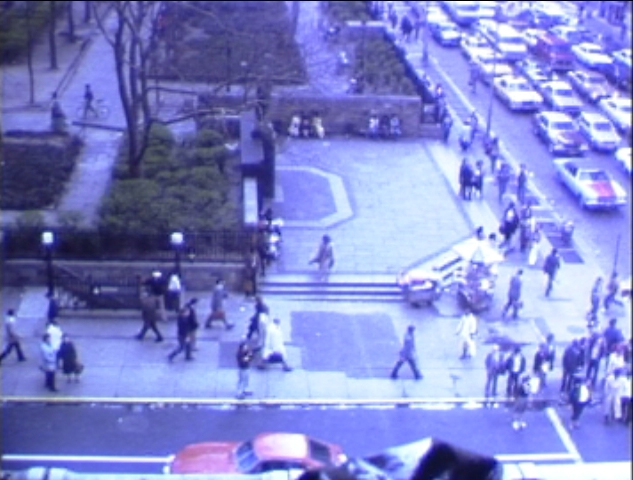A biweekly newsletter with public space news, resources, and opportunities.
A curated dispatch on all things public markets plus the latest announcements from the Market Cities Program.

As he sat in a PPS training watching time-lapse films of Bryant Park in the early 1980s, Keith Hampton realized he may have just found precisely the baseline he needed to examine how behavior in public space has changed in our contemporary digital world.
Hampton is a prominent voice in the burgeoning academic debate surrounding the impact of technology on social interaction. The prevailing assumption has been that mobile devices are beginning to dominate people’s behavior in public, causing increased isolation and diminishing human interaction. But one piece of information was missing from the debate—just how much human interaction in public space actually existed before the age of portable electronic devices, and how much, if any, has been lost?
The resulting study is a first for urban public space research. In the 1970s and 80s both William “Holly” Whyte and PPS used timelapse photography to analyze human behavior in public space with groundbreaking results. But Hampton and his team were the first to compare this archival footage to contemporary observations. By filming the same public spaces in the Whyte and PPS studies from similar angles and meticulously comparing the captured behavior, they found some surprising results.
In contrast to popular opinion, it turns out that over the last 30 years Americans have become less socially isolated in public space, even with the greater use of technology. According to the study, people are actually more likely to spend time in groups, men and women are more likely to spend time together, and there has been a marked increase in the percentage of women in public space overall. We sat down with Keith Hampton to delve into this comparative study and learn more about its implications in public space planning and research.

One of the study’s more surprising conclusions was that mobile device users were not overrunning public space as feared—they included only between 3 and 10 percent of those occupying public space. And among those using their devices, Hampton notes, “it seems they are using it when they are alone and waiting for someone to join them, or they’re using it in those transitional spaces [areas between destinations], which I don’t see as a loss to public space - and in fact, may allow people to reconfigure their time so as to better use public space.”
Hampton goes even further to argue that mobile device users actually provide a number of benefits to the social life of spaces. Previous research by Hampton including a paper about WiFi use in public spaces (which also utilized Whyte's behavioral mapping approach), indicated that many device users, although more likely to be alone, are still performing social activities: social networking, checking the news, reading blogs, or talking on the phone. Hampton explains, “The assumption that when people are on mobile phones that this somehow indicates a societal loss of some sort I find confusing. We’re saying that communication in person walking down the street briskly is good; communication on the mobile phone walking down the street briskly is bad.”
Despite the tendency to be alone, mobile phone users were also associated with an increased tendency to linger and with time spent lingering (not to be confused with loitering). This fact – combined with the overall increase in people socializing in public space – equates to a pretty favorable outlook for the future of public space.

In the larger sense, Hampton argues that design that takes technology into consideration is paramount for the future of cities. “As much as we use trees and water and other amenities to encourage people to spend time in spaces, to provide them with privacy, and to facilitate group interaction, we need to start thinking about how we can use another infrastructure. Just as we would provide water fountains, food, or other amenities, we have to think about how the infrastructure of these technologies fits into public spaces. Power outlets, the sizes of tables to accommodate different types of uses, seating arrangements that encourage different types of interaction - on and offline,” all while acknowledging that despite the perceived isolation, attracting these people is equally as important to create activity in public space.
The significance of long-term research like this project is clear. Not only can it help refute claims based on nostalgia or brief observations, it can help shape how we design public spaces. As Hampton points out, “It has always been the best practice of landscape architecture to return to places and spend time reflecting on how design is interacting with people to inform the future.”
As for suggestions for further research, Hampton concludes: “I think the most important thing that we can take away is the importance of data. The importance of taking the time to do the kind of analyses of these public spaces over time is the only way we really know how the social life of spaces is changing. As much as we like to think that we are these neutral observers who can stand back and idealize what places must have been like before, or what they can be in the future, we really don’t until we develop and take the time to do these systematic long term studies.”
The rich text element allows you to create and format headings, paragraphs, blockquotes, images, and video all in one place instead of having to add and format them individually. Just double-click and easily create content.
The rich text element allows you to create and format headings, paragraphs, blockquotes, images, and video all in one place instead of having to add and format them individually. Just double-click and easily create content.
Body Text Body Link
The rich text element allows you to create and format headings, paragraphs, blockquotes, images, and video all in one place instead of having to add and format them individually. Just double-click and easily create content.
Here is some highlighted text from the article.




Headings, paragraphs, blockquotes, figures, images, and figure captions can all be styled after a class is added to the rich text element using the "When inside of" nested selector system.
Headings, paragraphs, blockquotes, figures, images, and figure captions can all be styled after a class is added to the rich text element using the "When inside of" nested selector system.
Headings, paragraphs, blockquotes, figures, images, and figure captions can all be styled after a class is added to the rich text element using the "When inside of" nested selector system.

We are committed to access to quality content that advances the placemaking cause—and your support makes that possible. If this article informed, inspired, or helped you, please consider making a quick donation. Every contribution helps!
Project for Public Spaces is a 501(c)(3) tax-exempt organization and your donation is tax-deductible within the guidelines of U.S. law.